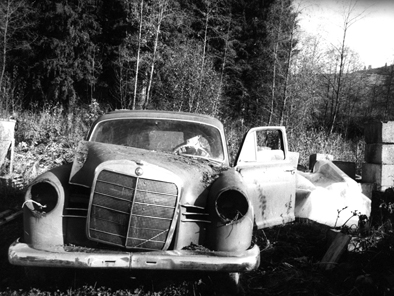Dream– Escape - Change
Christian Wagner on the making of the movie.
When I received yet another letter from him, which, in part, resembled
all his previous ones, constantly centering around the same topics, I
dragged out the whole pile and spent one afternoon re-reading them. Only
then I did realize that his letters were in fact not all alike despite
him dealing with certain recurring matters. For all his statements and
phrases each subsequent letter revealed one further piece of mosaic.
An entirely new and extended picture of a person was emerging before my
eyes, striking by its overwhelming power and emotional simplicity. His
three attempts to escape from prison remained imprinted in my mind, escape
in all its variants being a topic I was concerned with myself and which
I consider one of the crucial problems of our times. Therefor I decided
to filter one small fragment of reality in using one specific, well-researched
and true story: contemplation on the chances of breaking out in general,
exemplified by the story of a young convict. This short span of Franz's
life is to be representative of the wider context ‘dream – escape
– change’ rather than standing as an arbitrary piece of reality
that happened to be filmed as a documentary.
This film uses the language of black and white photography and the poetry
that is cited. Achieving authenticy by simply reconstructing lines of
action, background and story developments seemed inadequate. Above anything
else I aimed for an emotional plane, for feelings to be evoked among the
audience directly linked to their own individual lives and experiences.
There is no doubt about the rationale behind a facts-and-figures-based
approach to problems in our society. Yet I find it increasingly important
to grapple with particularly those problems on an emotional level that
neither directly concern us nor touch us in any way. This necessity is
even more evident in the light of growing anonymity and the destruction
of proven ways of co-existence among people.

There is some distinct analogy between our dreams and those of a young
convict in prison: overcoming conditions which paralyse and prevent us
from living our dreams; perhaps also the underlying hope that things might
improve, albeit that time and circumstances speak against it; finding
away out of the misery surrounding us.
During the long process of implementing this project I had many doubts
as to my qualifications for dealing with such complex matters, especially
with the limited funds available. Given adequate financial means, enough
time, and even the best of circumstances - I still believe that some facets
of these questions would remain unfathomable. Perhaps there are questions
one will never be able to answer completely, cropping up all through our
lives, from which one cannot escape. Like Franz: by escaping from prison
and stealing a scooter he gets himself deeper and deeper into labyrinths
and hostile jungles.
To me one of the most beautiful scenes in this film shows Franz and Andrea
in a wrecked Mercedes, rusting away on a derelict construction site. Franz
answers Andrea's questions about his feelings and desires; his fingers,
however, are writing a different story on the front window. Nervously
he draws lines - haphazardly it seems - which then take the distinct shape
of a labyrinth. At the end of his quiet, broken flow of words he wipes
out these hierogliphics of his sub-conscience with a brisk movement of
his hand. Then the barriers between him and the camera, between Franz
and the audience, too, may be wiped out for good.